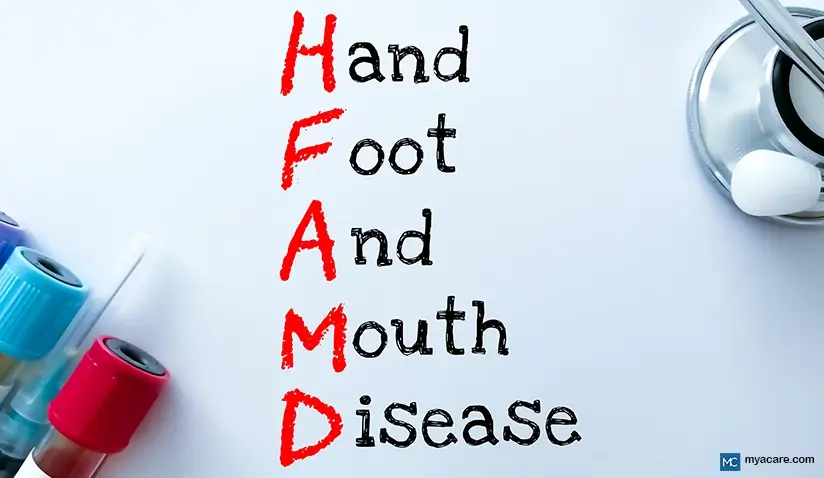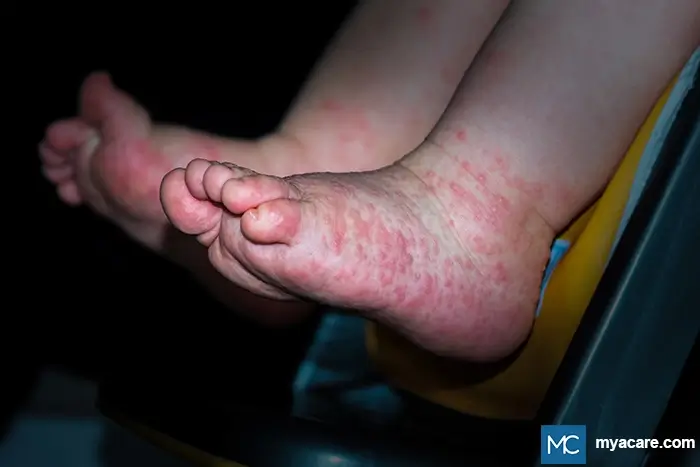Hand, Foot and Mouth Disease

What is Hand-Foot-Mouth Disease?
Hand-Foot-Mouth Disease (HFMD) is a viral illness that presents as a rash on the hands and feet, accompanied by mouth sores. It is a mild disease, but it can be contagious.
Who Can Get HFMD?
Young children and infants are most commonly affected, but it can also affect adults. It has a worldwide distribution and is easily transmissible, which is why it spreads rapidly at day care centers, summer camps, schools, or even within the family. Most cases occur during the summer and fall seasons. Adults who are affected may or may not present with symptoms.
Risk Factors:
- Age (younger than 10 years)
- Children in child care settings
What Causes HFMD?
HFMD is mainly caused by the coxsackievirus A16, A6, and enterovirus 71. The virus is transmitted by a number of ways:
- By person to person contact
- Contact with respiratory droplets containing the virus particles (when an infected person coughs or sneezes)
- Contact with contaminated objects or surfaces then touching your eyes, nose, or mouth
- Contact with an infected person’s nasal secretions, saliva, stool, fluid from skin blisters
HFMD is most contagious during the first week of illness, with an incubation period of 3-6 days.
What are the Signs and Symptoms of HFMD?

HFMD begins with nonspecific prodrome symptoms such as fever, sore throat, feeling unwell, and loss of appetite. One to two days after prodrome symptoms, patients can develop painful sores or blisters on their mouth including the tongue, cheeks, and gums, accompanied by a rash on the hands and feet. The lesions are bright pink dots that progress to form fluid-filled, oval-shaped, small blisters that are 4-8mm in size on the palms, soles, sides of hands and feet, and even on the buttocks and/or genitalia.
How is HFMD Diagnosed?
Hand-Foot-Mouth Disease is a clinical diagnosis. Laboratory tests or skin biopsies are not usually required to make the diagnosis. For atypical cases, a viral culture or PCR test of fluid from the skin vesicles or from stool samples can be done. For some cases, determining whether the HFMD is caused by the coxsackievirus or enterovirus has some prognostic significance. This can be done through serology.
How is HFMD Treated?
Hand-Foot-Mouth Disease is a viral skin disease; therefore, treatment is primarily supportive. The primary goal is to prevent dehydration and reduce discomfort. Supportive measures include over-the-counter medications for pain and fever, and keeping the patient well-hydrated. For those with painful mouth sores, a topical oral anesthetic may afford some relief.
Other tips for managing HFMD:
- Proper handwashing
- Disinfect surroundings, especially if in contact with an HFMD patient
- Avoid close contact
- Educate patients and parents about hand hygiene techniques, and about HFMD
Clinical Course and Prognosis of HFMD
Hand-Foot-Mouth Disease usually resolves in 7 to 10 days, and the prognosis is usually excellent. However, infection with enterovirus 71 can cause more severe illness. Some complications of HFMD are the following:
- Dehydration
- Encephalitis
- Viral meningitis
- Persistent stomatitis
- Aseptic meningitis
- Pneumonia
- Myocarditis
- Pancreatitis
- Pulmonary edema
Take-Home Messages
HFMD is a self-resolving condition, and usually has mild symptoms. However, some unusual cases may have complications. It is better to consult a dermatologist in order to get the proper diagnosis and guidance for treatment.
To search for the best health providers for dermatology in Croatia, Germany, Greece, Italy, Malaysia, Singapore, Slovakia Spain, Thailand, The UAE, the UK, and the US, please use our free search engine.
To search for the best healthcare providers worldwide, please use the Mya Care search engine.
Dr. Lauren Livelo is a board-certified dermatologist from the Philippines. She has a degree in Medicine from the University of the East Ramon Magsaysay Memorial Medical Center, and has completed her dermatology residency training in the Research Institute for Tropical Medicine. Aside from her private practice, she enjoys writing about skin care and diseases of the skin.
References:
Featured Blogs



